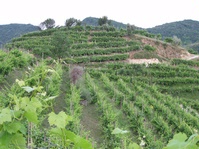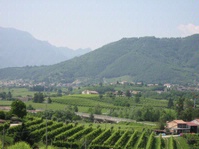I confess to having shifted in my thinking about residual sweetness in high quality Prosecco Superiore DOCG, and based on tastings in Italy in May, I’ve become pretty settled in my altered view. After first encountering a fair number of bottles that achieved balanced excellence without much sugar on three previous trips, I started to look down a bit at ones with more of it,  both because I knew it wasn’t strictly necessary and also because sugar can be used to cover minor flaws.
both because I knew it wasn’t strictly necessary and also because sugar can be used to cover minor flaws.
However, after tasting hundreds of higher-end Proseccos in recent years at all levels of sweetness, I’ve gradually come to the conclusion that the grape variety actually seems most natural and harmonious when finished with residual sugar levels approaching (or at) the “Extra Dry” bottling designation.
The light floral aromas of Glera (as the grape is now called officially, after “Prosecco” was changed from a varietal name to a geographic indicator) seem more expressive in wines of this type, and the flavors seem fuller and more generous, and even the wines’ texture seems different…“fluffier” even though the flavors seem fuller.
Among the producers I visited on this most recent trip was Adami, and the house’s “Dei Casel” offers a great case in point while also offering an illuminating opportunity for experimentation. The Adami wines are well represented by Dalla Terra in the USA, and are widely available across the  country, making it possible to taste this head-to-head (preferably “blind") along with the extremely dry “Col Credas” Brut as well as the notably drier “Bosco di Gica” Brut.
country, making it possible to taste this head-to-head (preferably “blind") along with the extremely dry “Col Credas” Brut as well as the notably drier “Bosco di Gica” Brut.
Regarding your conclusion from this tasting experiment, I don’t want to “lead the witness” (as they say in legal circles), but neither do I wish to be coy. Stated simply, I “admire” the Brut wines more because I know they are more difficult to craft in a way that results in harmonious, balanced bubbly. But in purely hedonistic terms, I "enjoy" the “Dei Castel” Extra Dry every bit as much, as it offers at least as much pleasure, if not more.
Although it is often true that drier wines can be enjoyed for a longer duration, and that sweeter ones can become a bit tiring after the first glass, that’s not uniformly the case, nor is it a fixed reality that isn’t subject to other factors.
For example, I’ve found that wines in the Prosecco Superiore Extra Dry category harmonize beautifully with the smoky, spicy, salty flavors of charcuterie. So, if you’re in a mood to experiment, don’t just try the Adami wines side-by-side, but extend your lab work to a sampling of the “Dei Castel” Extra Dry with some spicy salami and a few slices of good Proscuitto di Parma … and see if you can resist a second glass of the wine.
1
